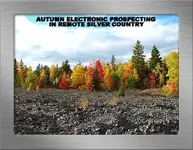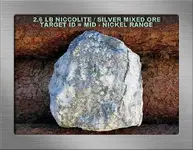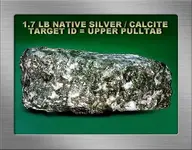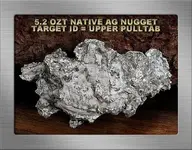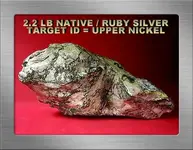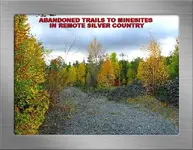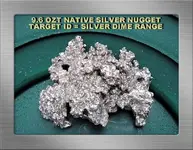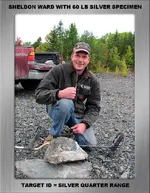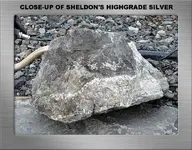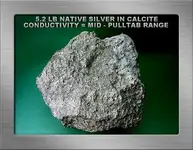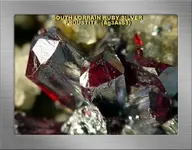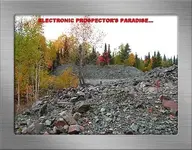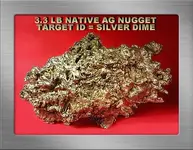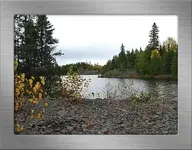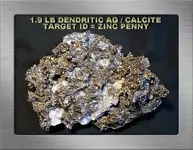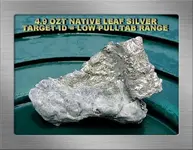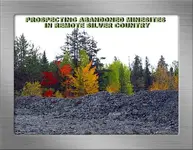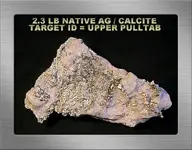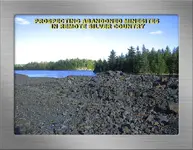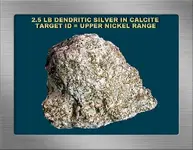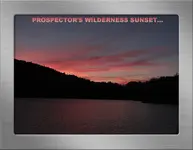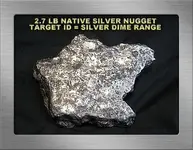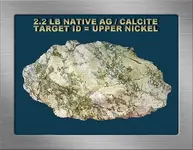Jim Hemmingway
Hero Member
ABANDONED TRAILS IN SILVER COUNTRY
Introduction…
Silver country represents a small part of a vast, heavily forested wilderness perched on the sprawling Precambrian Shield here in northeastern Ontario. Away from the small towns and villages, and widely scattered farms and rural homesteads, there exists a largely uninterrupted way of life in the more remote areas. There are uncounted miles of lonely country backroads, overgrown tracks leading to abandoned mining camps, innumerable rough timber lanes, and a virtually infinite tangle of winding trails that reach deeply into the distant forests.
Nothing in my experience has been so completely companionable as the soft forest whisperings and the beckoning solitude that reigns over this ruggedly beautiful country. This is where my carefree days of autumn prospecting have been agreeably spent for many years. We returned again this year to unbounded, satisfying autumn days of kicking rocks, exploring and detector-prospecting adventures, followed by evenings spent evaluating silver ores and hot coffee over blazing campfires.
Irrespective of silver recoveries, the flaming autumn colors of the boreal forest are the real treasure of the season. They persist for only a few short weeks, reluctantly yielding to the autumnal yellows of the tamarack, birch, and aspen in sharp contrast to the deep conifer greens. Scenery as depicted below accentuates your enthusiasm to get into the field, and pretty much ensures that an autumn prospecting trip to silver country is a memorable experience.
General Discussion…
Unprecedented, persistently wet conditions eliminated any potential for a banner season, but nonetheless we did manage to find considerable worthwhile silver. In addition to an assortment of rich silver and associated minerals, my friend Sheldon Ward recovered a large, very high conductive native silver ore that we’ll take a closer look at shortly. Most of my quality silver finds were fairly small… although a specimen grade silver ore at five pounds was found during the final week of the trip, and frankly I felt very fortunate to get it. Larger material was recovered, for example a 24-pound highgrade silver ore from the same area… but these invariably were mixed ores dominated by cobalt and various arsenides, most notably niccolite as illustrated below.
On a more positive note, we both found plentiful small silver generally ranging between one-half and ten ounces that added real weight to the orebag over the season’s duration. It is much easier to find small but rich, high character silver than is the case with larger material. Even so, specimen grade detectable silver in any size range is becoming increasingly difficult to find at many of the obvious, readily accessible sites nowadays.
The photo below is a pretty fair representation of the overall quality, although anything below a half-oz was excluded from this shot… such are not terribly photogenic beside larger samples. Some rich ‘nuggety’ ores were HCl acid-bathed to free the silver from carbonate rock, and all samples were subjected to a rotary tool circular wire brush to remove surface residues, followed by a dish detergent wash and rinse.
By way of a brief background explanation to readers unfamiliar with this prospecting application, we search for more valuable coin-size and larger pieces of silver. Natural native silver target ID is determined by physical and chemical factors such as silver purity, types of mineral inclusions, structure (for example… dendritic, plate, disseminated, massive), size, shape, and the profile presented to the coil. Virtually all natural silver from this area will target ID from low foil up to a maximum of silver dime range. Only infrequently over the years have we found isolated, rare examples of our naturally occurring silver exceeding that range.
The specimen depicted below is a commonplace example of silver typically recovered here. It isn't terribly large or particularly handsome… but it is mostly comprised of native silver by weight. Its target ID is a bit elevated from the usual, but consider that even small changes to some of the more influential factors listed above can significantly alter target ID. I tend to pay minimal attention to it when evaluating samples.
It was detected adjacent to an abandoned mining track that leads directly to a former mill site at the mining camp scene depicted above. No treatment required other than a leather glove rubdown followed by a soapy wash and rinse… in fact it looked quite presentable fresh out of the dirt. The darker material you see is heavily tarnished native silver that I intend to leave undisturbed.
Ground conditions also play an important role in determining target ID, and refer to factors such as strength of non-conductive magnetic susceptible iron minerals, ground moisture content, proximity of adjacent targets, and disturbed ground. These factors sometimes contribute to good silver at depth producing a VLF target ID in the iron range.
Probably the best photo example available to me is a specimen found a few years back at good depth in tough magnetic diabase. It produced a predominantly iron target ID on the Fisher F75. It was detected in a fairly low trash area, the signal was suspect, and it was checked with the groundgrab feature. In this instance, there was no ground phase reduction to more conductive values as would be anticipated over rusty iron or a positive hotrock, and so the target was dug.
But otherwise, the rule of thumb over questionable weaker signals is to remove some material to acquire a stronger signal and target ID readout before making a decision to continue digging in our difficult, hard-packed rocky substrates, or move on. If there is the least doubt we dig the target and learn what actually produced the signal.
The specimen depicted below was found by eyesight while hiking along an old abandoned rail track. In the field our rock samples seem more attractive or valuable than they do once we return to camp, where we tend to view them far more critically. If they don’t look to have good specimen grade potential, my samples either get chucked or given away. But that’s just me… others are more resourceful with unwanted samples, they’re refined by some, subjected to treatments, or slabbed… and ultimately sold. In any case, this rock didn't terribly impress me and was placed with the other discards on the picnic table. But nobody other than my wife seemed much interested in it, and that is how it came to be included here.
In its original condition, it could only be described as nondescript, with very little showing on the surface prior to treatment. It did produce a broad solid PI signal, despite that the few surface indicators were non-conductive dark ruby silver pyrargyrite and to a much lesser extent what I think is the black silver sulfosalt stephanite. To see more, it was acid-washed to expose silver and associated minerals, cleaned-up with a rotary tool followed by a dish detergent bath and rinse.
Both these minerals produce a good luster that makes them a bit more difficult to distinguish from native silver in a photo. But in reality it is easy to see the differences and do some simple tests to confirm if necessary. As it turned out… the sample does have a good showing of dendritic native silver… a timely reminder that metal detectors see what we initially can’t see inside rocks.
Abandoned Trails, Minesite Tracks and Roadbeds…
Abandoned, frequently overgrown trails, mining tracks, and roadbeds provide convenient routes to prime detecting sites that otherwise would be much more difficult to access. But the important thing is that most such routes were built with discarded mine tailings to considerable depth, and contain good silver more frequently than you might think possible. Some snake through the bush to more remote areas, but the vast majority of these now abandoned routes were built to service existing minesites at the time. They were used to transport discarded rock to the tailing disposal areas, and silver ores to storage buildings and to mill sites, and generally to service other mining camp requirements.
We know from research and experience that silver was misgraded, inadvertently misplaced, or lost directly from spills to eventually reside on, within, or alongside these now abandoned trails and roadbeds. These mine tailings… frequently containing rich silver… were also used to build storage beds, minesite entrances, loading ramps, and as noted… routes to facilitate waste rock transport. All these offer excellent, obvious prospects to search with a suitable metal detector.
The nugget below, with several other pieces, was found in the tailings adjacent to the abandoned track in the photo above. Some good weather following a horrendous week of persistent heavy rainfalls prompted me to head out late one afternoon for some casual detecting. I had sampled those tailings earlier in the season but nothing by way of thorough searching. And while the silver was generally small, it had been surprisingly good quality. So I was looking forward to a few relaxing hours of detecting… nothing ambitious that late in the day… just happy to get out of camp.
That particular spot formerly housed storage beds, and was now replete with large rusty nails. I should have used a VLF unit, as things would have gone much more quickly. VLF motion all-metal detection depth in that moderate ground would pretty well match Infinium equipped with the 8” mono, with the further advantage of target ID. If conductive pyrrhotite hotrocks had also been present, I would have switched over to my F75 or MXT.
But I stayed with the Infinium primarily because I enjoy using it. By comparison it is slow going, but that isn't such a bad thing over potentially good ground. It silences what can be described as VLF ground noise, in addition to sizable non-conductive mafic hotrocks in this area. It also has some limited high conductive iron handling capability, for example elongated iron such as drillrods or rail spikes at sufficient depth that VLF units… even using small iron discrimination… misidentify with perfectly good signals and non-ferrous target ID readouts. More information on this subject can be found at… Garret Infinium Silver Rock Hunting - Revised Edition February 2011 White's TDI Pro in Silver Country [including Infinium Comparison]
Nearly all the signals proved to be nails, plus one drillbit with a perpendicular profile to the coil. The silver below produced a low-high signal in zero discrimination and a good high-low signal in reverse discrimination at maybe eight to ten inches depth… almost identical to the drillbit. The exposed silver was unusually tarnished and the remainder partially embedded in carbonate rock. It was acid-bathed to free the silver, cleaned with a rotary tool diamond bit and circular wire brush, followed by a detergent wash and rinse.
While searching one such abandoned route with his Fisher F75, Sheldon Ward found a large highgrade silver ore comprised of a thick calcite vein containing massive dendritic native silver. It should weigh about 20 lbs give or take a bit, and is attached to dark country rock. It generated a moderate but broad signal from several feet depth, requiring about 30 minutes of hard pick and shovel work to recover it. It possesses an unusually elevated target ID well above silver dime range, making it quite rare indeed. Over nearly 30 years in this area and perhaps thousands of silver samples later, I've seen only a handful of silver produce a similar target ID.
On site we obviously have the benefit of closely examining the vein material, but it’s impossible for readers to evaluate the silver based on the photos below because of the camera to rock distance and the smudged dirt layer on the vein. And outdoor photos do tend to make native silver look much like grey rock. A better view of the cleaned sample can be had at Sheldon’s photobucket link to a half-minute video.
http://vid307.photobucket.com/albums/nn289/InsaneTundra/P1020237.mp4
Sheldon if you happen to be reading along here, congratulations on your many superb silver and associated mineral recoveries over the past year. Nothing that your dedication and persistence achieves in the years to come will ever surprise me.

Persistence Pays Dividends…
Let’s wrap things up with a tale about the rock sample below. It was recovered at the edge of a tangled overgrown trail near a former millsite just a few years ago. Its recovery exemplifies that the more you work towards your objective of finding silver or gold, the more likely your luck will correspondingly improve.
I’d been searching that particular area for two days without meaningful results while evaluating a newly purchased Garrett Infinium for this application. The second day had again been filled with digging hard-packed rocky substrates for iron junk, worthless or otherwise unwanted arsenides, and plenty of conductive pyrrhotite hotrocks. As the sun was reaching for the western horizon, I decided to make one final effort before heading elsewhere the following day.
Methodically working along the old track towards the mill, lots of old diggings were plainly evident. But previous hunters had avoided an area with a scattering of large, flat rusty iron pieces and other miscellaneous modern trash. I moved quickly to clear it away, because daylight was fading fast beneath the dense forest canopy. My Infinium soon produced a surprisingly strong high-low signal that practically vanished in reverse discrimination… a promising indication of naturally occurring ores. I dug down a foot before my Propointer could locate the signal.
Probability says that it could have been any number of possible targets altogether more likely than good silver. But fickle Lady Luck was more kindly disposed towards me that evening. The rich, finely dendritic piece depicted below was in my gloved hands just as twilight was stealing across that lonely abandoned trail in remote silver country.
A Final Word…
A special mention to my friend Dr. Jim Eckert. I hadn’t seen much of Jim recently, but happened across his trail late one overcast afternoon in the outback. I was about to hike into a site when this fellow came flying down the trail on a motorbike, and despite the riding helmet I recognized him. We had a good long chat about this and that…
Later in the season, one bright sunny afternoon at the site of my short-lived testhole diggings, Jim stopped around to show me a recent specimen find comprised of native silver and possibly crystalline stephanite. We talked mineralogy and other interests many hours until finally the sun was going down. These were highlights of the trip, and I want to say how much I enjoyed and appreciated having that companionable time together.
Thanks to everyone for dropping by. We hope that you enjoy presentations about our silver, particularly since it is different from what many rockhunters normally encounter in their areas. All the very best with your prospecting adventures… perhaps one day it will be our good luck to meet you in the field.
Jim Hemmingway
December 2014
Last edited:
Upvote
4

